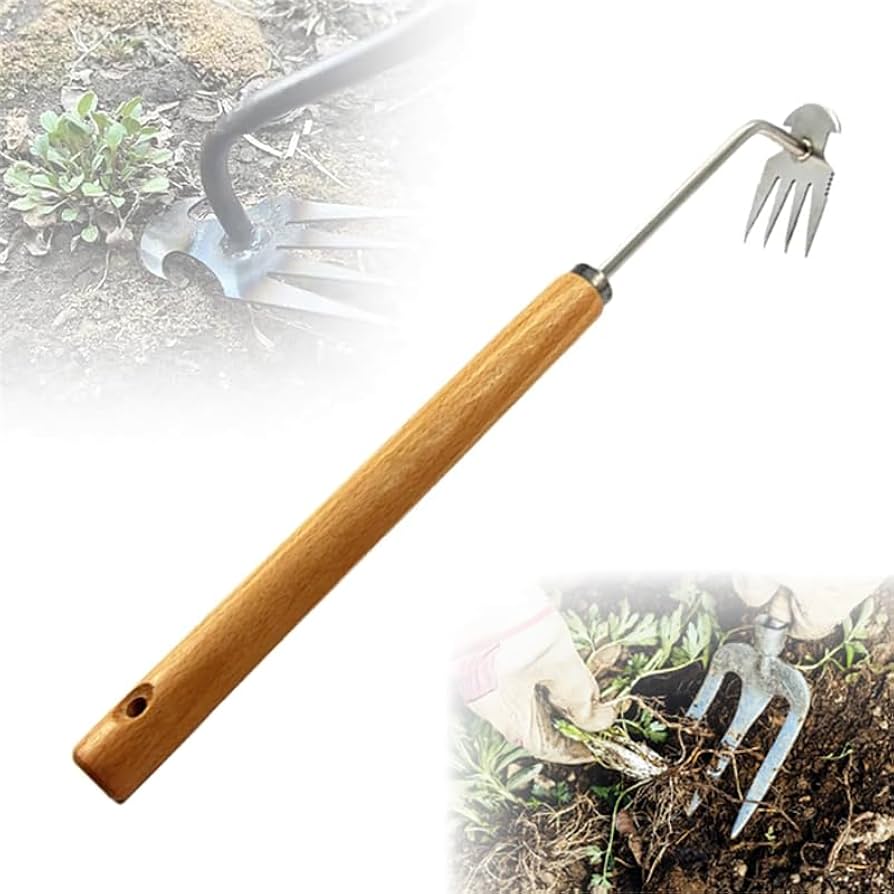Essential Weeding Tools for a Thriving Garden: Your Complete Guide
Maintaining a beautiful and productive garden requires constant vigilance against the persistent threat of weeds. These unwanted plants compete with your carefully cultivated flowers, vegetables, and herbs for nutrients, water, and sunlight. To effectively combat this perennial problem, gardeners need a well-stocked arsenal of essential weeding tools for garden. This comprehensive guide explores the various implements available to help you keep your garden weed-free and flourishing.
Understanding the Importance of
Effective weed control starts with having the right tools at your disposal. While hand-pulling weeds can be effective for small areas, it quickly becomes time-consuming and labor-intensive in larger gardens. Moreover, improper weed removal techniques can leave roots behind, allowing weeds to regrow rapidly. The right weeding tools not only make the task easier and more efficient but also ensure more thorough weed removal, reducing the likelihood of regrowth.
Furthermore, using appropriate weeding tools helps protect your garden’s ecosystem. Many weeding implements allow for precise removal of unwanted plants without disturbing the surrounding soil or damaging nearby desired plants. This targeted approach maintains soil structure, preserves beneficial microorganisms, and minimizes disruption to your garden’s delicate balance. By investing in quality weeding tools, gardeners can save time, reduce physical strain, and promote the overall health of their garden.

Hand Tools for Precision Weeding
For small-scale weeding and working in tight spaces, hand tools prove invaluable. The classic hand trowel serves as a versatile implement for digging out weeds with shallow roots. Its pointed tip easily penetrates the soil, while the scoop-shaped blade allows for complete removal of the weed and its root system. For more stubborn weeds with deeper roots, a hand fork or cultivator can loosen the soil around the plant, making extraction easier.
Another essential hand tool is the weeding knife or hori-hori. This multi-purpose tool features a sharp, serrated edge on one side and a straight edge on the other. The pointed tip easily slides into the soil to pry out weeds, while the serrated edge can saw through tough roots. Many gardeners consider the hori-hori indispensable for its versatility in weeding, planting, and general garden maintenance.
For precision work around delicate plants or in rock gardens, the Cape Cod weeder proves highly effective. This L-shaped tool features a narrow, pointed blade that slides easily between plants and under weed roots. Its unique shape allows for leverage when prying out stubborn weeds, making it especially useful for removing weeds growing in cracks or tight spaces.
Long-Handled Weeding Tools for Comfort and Reach
While hand tools offer precision, long-handled weeding implements provide the advantage of reach and leverage, reducing the need for bending and kneeling. The classic garden hoe remains a staple in many gardeners’ tool sheds. Available in various shapes and sizes, hoes efficiently clear large areas of surface weeds. The draw hoe, with its flat blade perpendicular to the handle, works well for chopping and pulling weeds, while the scuffle hoe (also known as a push hoe) excels at slicing through weed stems just below the soil surface.
For dealing with deeper-rooted weeds, the garden fork proves invaluable. Its sturdy tines can loosen compacted soil and lift out entire weed plants, roots and all. When working in tight rows or around established plants, a narrow-bladed spade offers precision and power. These tools allow gardeners to leverage their body weight for more efficient weed removal while maintaining a comfortable upright posture.
Another long-handled tool gaining popularity is the stand-up weeder. This innovative implement features a claw-like mechanism at the end of a long handle. The user positions the claws around the weed, steps on a foot pedal to drive the tool into the soil, then tilts the handle to extract the weed. This design allows for weed removal without bending or kneeling, making it an excellent choice for those with mobility issues or back problems.

Specialized Weeding Tools for Specific Scenarios
Certain gardening situations call for specialized weeding tools designed to address specific challenges. For weeding between paving stones or in tight cracks, the paving weeder or crack weeder proves indispensable. This tool features a thin, L-shaped blade that can reach into narrow spaces to scrape out weeds and their roots. Similarly, the asparagus knife, with its long, narrow blade, excels at removing weeds in tightly planted rows without disturbing surrounding crops.
When dealing with expansive weed patches or preparing new garden beds, a wheel hoe can significantly speed up the process. This tool consists of a sharp blade attached to a wheel and handles, allowing the user to push it through the soil, cutting weeds off at the roots. For larger areas or more stubborn weeds, gas-powered or electric cultivators can quickly turn over soil and uproot weeds, though care must be taken not to damage desired plants.
In lawns, weeds present a unique challenge, often requiring specialized tools for removal without damaging the surrounding grass. The stand-up weed puller, designed specifically for lawn use, features a claw mechanism that grips the weed and extracts it, roots and all, while minimizing disturbance to the turf. For dealing with individual dandelions or other tap-rooted weeds, the dandelion digger (also known as a dandelion weeder or fishtail weeder) proves highly effective. Its forked tip allows for precise removal of the entire root system.
Innovative and Eco-Friendly Weeding Solutions
As gardening practices evolve to become more environmentally conscious, new weeding tools and techniques have emerged to address these concerns. Thermal weeders, which use heat to kill weeds, offer a chemical-free alternative to herbicides. These tools come in various forms, from simple propane torches to more advanced electric models that apply precise doses of heat to weeds. While effective, users must exercise caution to avoid damaging desired plants or creating fire hazards.
Another eco-friendly approach involves the use of ground cover fabrics or mulch mats. These materials suppress weed growth by blocking sunlight and preventing weed seeds from germinating. When used in conjunction with traditional weeding tools, these preventive measures can significantly reduce the overall weeding workload. Additionally, some gardeners have found success with vinegar-based organic herbicides, applied using specialized sprayers designed for precise application to minimize impact on surrounding plants.
For those seeking to minimize soil disturbance, the oscillating hoe (also known as a stirrup hoe or scuffle hoe) offers an effective solution. This tool features a sharp, looped blade that moves back and forth as the gardener pushes and pulls it just below the soil surface. This action severs weed stems without bringing buried weed seeds to the surface, where they might germinate. The minimal soil disruption also helps preserve beneficial soil microorganisms and structure.

Maintaining and Caring for Your Weeding Tools
To ensure the longevity and effectiveness of weeding tools, proper maintenance is crucial. After each use, clean tools thoroughly to remove soil and plant debris. This prevents rust and reduces the spread of plant diseases. For tools with wooden handles, occasionally treating the wood with linseed oil helps prevent splintering and extends the life of the handle. Metal parts should be kept sharp for optimal performance; a file or sharpening stone can be used to maintain cutting edges on hoes, knives, and other bladed tools.
Proper storage also plays a vital role in tool maintenance. Hang tools in a dry, sheltered area to prevent moisture damage and keep them easily accessible. For hand tools, consider using a tool roll or caddy for organized storage and easy transport around the garden. Before storing tools for extended periods, such as over winter, apply a light coating of oil to metal parts to prevent rust.
Regular inspection of tools helps identify any damage or wear that might affect performance. Loose handles should be tightened or replaced, and any cracked or severely worn parts should be repaired or replaced promptly. By maintaining tools in good condition, gardeners ensure they have reliable implements ready for action when weeds inevitably appear.
Choosing the Right Weeding Tools for Your Garden
Selecting the most appropriate weeding tools depends on various factors, including garden size, soil type, types of weeds encountered, and the gardener’s physical capabilities. For small urban gardens or container plantings, a basic set of hand tools like a trowel, hand fork, and weeding knife may suffice. Larger gardens or those with persistent weed problems might require a more extensive collection, including long-handled tools and specialized implements.
Consider the prevalent weed types in your garden when choosing tools. Areas with primarily shallow-rooted annual weeds might be effectively managed with hoes and scuffle tools. Gardens plagued by deep-rooted perennial weeds will benefit from tools designed for complete root extraction, such as garden forks and stand-up weeders. Soil type also influences tool choice; sandy soils might allow for easier use of hand tools, while clay soils may require sturdier implements capable of penetrating compacted earth.
Gardeners should also consider their own physical limitations and preferences. Those with back problems or limited mobility might prioritize long-handled tools or stand-up weeders to minimize bending and kneeling. Alternatively, gardeners who enjoy close interaction with their plants might prefer the precision offered by hand tools. By assessing these factors, gardeners can assemble a personalized toolkit that meets their specific needs and makes the weeding process as efficient and enjoyable as possible.

Combining Tools and Techniques for Effective Weed Management
While having the right tools is essential, combining various weeding implements with complementary gardening practices yields the best results in weed control. Mulching, for instance, serves as an excellent preventive measure against weed growth. After using weeding tools to clear an area, applying a layer of organic mulch or landscape fabric helps suppress future weed development. This integrated approach reduces the frequency and intensity of weeding sessions over time.
Another effective strategy involves timing weeding activities strategically. Tackling weeds when they’re young and have shallow root systems proves much easier than battling mature plants. Regular, light weeding sessions using hand tools or hoes can prevent weed populations from becoming established. Additionally, weeding after rain or irrigation, when the soil is moist, facilitates easier removal of entire root systems.
Crop rotation and companion planting also play roles in weed management. By changing the layout of garden beds each season, gardeners disrupt weed patterns and reduce the buildup of weed seeds in specific areas. Companion planting with ground cover plants or densely planted crops can shade out weeds. Reducing their ability to germinate and grow. These cultural practices, when combined with appropriate tool use. Create a comprehensive weed management strategy that promotes a healthier, more productive garden.
Conclusion
In conclusion, effective weed control in gardens relies on a combination of the right tools, proper techniques, and integrated management strategies. By understanding the various weeding implements available and how they complement other gardening practices. Enthusiasts can maintain beautiful, thriving gardens with minimal weed interference. From precision hand tools to innovative eco-friendly solutions, the world of weeding tools offers something for every gardener and every situation.
As garden maintenance evolves, new tools and techniques will undoubtedly emerge to make weed control even more efficient and environmentally friendly. By staying informed about these developments and maintaining a well-curated selection of weeding tools. Gardeners can ensure they’re always prepared to tackle the persistent challenge of weeds. With the right implements in hand and a strategic approach to weed management. Cultivating a lush, weed-free garden becomes an achievable and rewarding endeavor for







